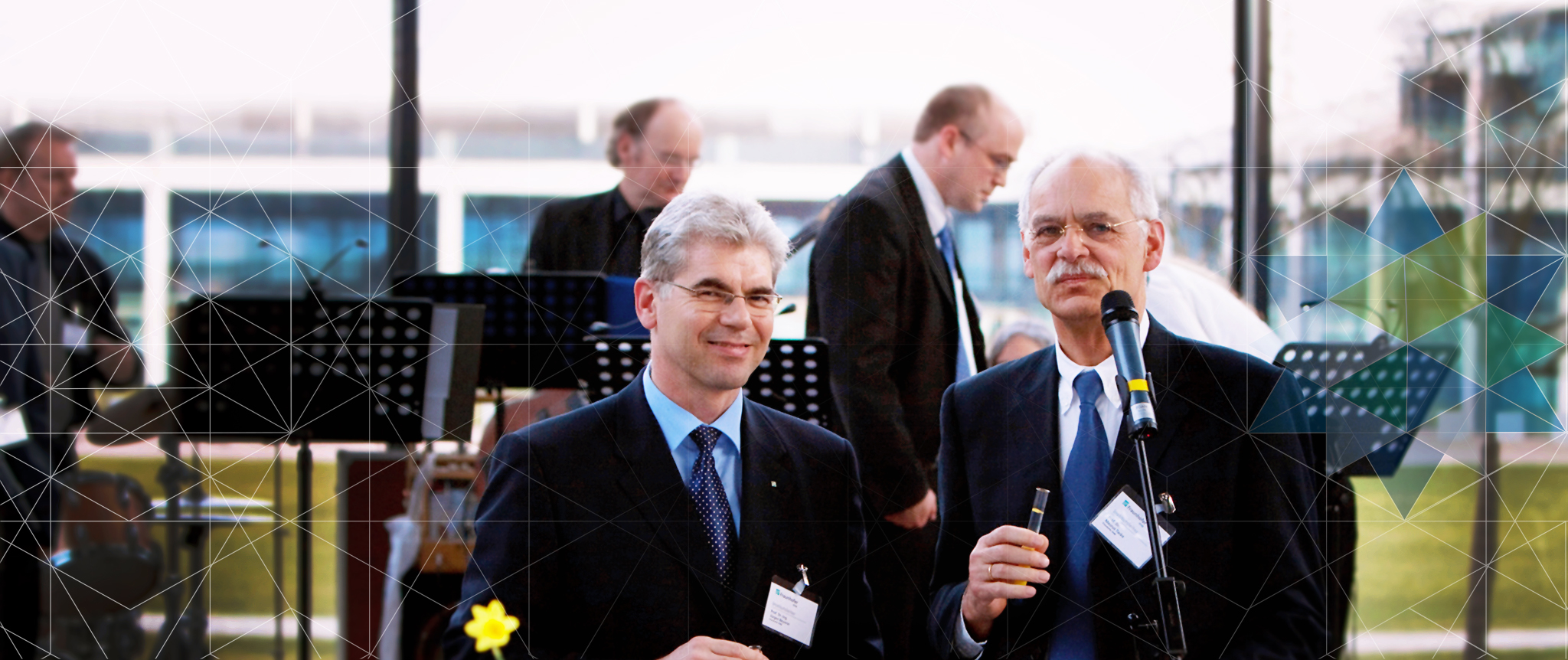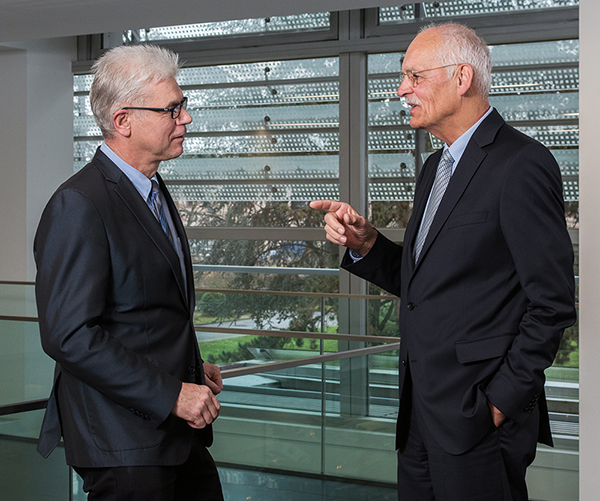What happened after 2004?
Beyerer: The German Science Council carried out its evaluation in 2006. I advocated recommending a merger for the reasons mentioned earlier. In its report in late 2007, the German Science Council made an unequivocal recommendation to integrate FGAN into Fraunhofer and to merge our two institutes. Then it was up to the ministries and Fraunhofer to decide if they would act on this recommendation. The integration took place in mid-2009 and the merger took effect at the beginning of 2010.
Tacke: However, this was preceded by protracted debate. Fraunhofer and the German Federal Ministry of Education and Research (BMBF) voiced concerns that quality might suffer as a result. I suspect that an ingrained aversion to supporting military research also played a role here. Ultimately, though, the Science Council’s verdict persuaded everybody that the merger would be a good thing. On the other hand, some at FGAN feared that working along the lines of the Fraunhofer model would bring on too much economic pressure, with the thinking being that this would strip us of our academic freedom and scientific autonomy.
What kind of relationship existed between the institutes and yourselves?
Beyerer: We were always aware of each other’s existence, of course. I was at FOM with former IITB director Hans-Achim Kuhr in 2004 for my inaugural visit. When the talk turned to the merger, we debated it, and there were certainly some opposing viewpoints. We held many discussions about the pros and cons and grappled with the question of how it could be done. Then, when it became clear that the integration and merger were going to happen, the question was how do we come together on an equal footing without this feeling like a takeover? The departments had their reservations. After all, they had been rivals to some extent in the past.
Tacke: Despite there having been some collaboration and joint projects, the feeling of being competitors prevailed because both institutes were working in the defense market and in image exploitation.
Beyerer: And suddenly there we were, sat at the same table, talking about how to work together in a future joint institute, about how to bridge divides. In the end, it all comes down to trust. It is my firm conviction that the merger was only successful because the two of us, as persons, managed to work well together.
Tacke: When the decision stood, it was clear that we would have to unite this house. And we did exactly that – together.
Beyerer: Yes, once the decision to integrate and merge had been made, we both put the pedal to the metal and worked on the structures and on building trust between our people.
What did this work toward the merger entail?
Beyerer: We started off with regular strategy seminars, which are still held today. And we launched initiatives with a communicative touch to build trust – for example, a cooking course that paired one person from FOM with another from IITB for the two to cook as a team. It was during this phase that ideas for IOSB’s structure emerged – that the specialist departments ought to be the institute’s actual constituents, and that the heads of department ought to remain second-tier managers with the authority to embed their departments in the science and engineering communities and take budgetary responsibility. At the same time, we decided to set up business areas to present a unified, readily identifiable face to the markets. However, the departments support this added structure without being subservient to it. To both of us it was important to involve all the department heads in this process so that everyone can get behind the result.
And how did the workforces feel about it? Wasn’t there tension?
Tacke: It gradually became clear to everyone that a merger was growing more and more likely. Thanks to my history at Fraunhofer, I was able to explain to the FOM staff what was in store for them. I had the impression that they accepted it – they didn’t break out in cheers, but they weren’t overly concerned either. There were some reservations in the works council that the pressure might be too great and that there would be financial drawbacks. And some in IITB feared that defense research would dominate. But both of these concerns were put to rest over time.
Beyerer: I never had any hard arguments pointed out to me. People were curious. Some may have had a concern or two, for example, if their jobs were going to be relocated to Ettlingen. The works council wanted a severance scheme, but we explained to them that this merger is not at all about downsizing. It was about two successful institutes seeking to join forces to stride forward into the future even more vigorously. Growth could certainly be part of this.
So did the newly-formed IOSB get off to a good start without any teething troubles?
Tacke: Absolutely. We had enough seed funding to pursue market-driven projects that would move us even closer to the Fraunhofer world. And the benefits of our structure soon became apparent. The business areas provided anchor points in various fields of application for the departments, so they had the support they needed when they set out to explore new use cases. The merger turned out to be a success even though the base funding from BMVg was not reorganized as we had hoped it would be.
Beyerer: From day one, we have been working within a complex organizational framework, which – on top of that – also varies from site to site. But as you can gather from the institute’s positive development, we have managed to make the best of it. What has always been important to us is that we refuse to let surrounding circumstances hinder our research work, and that we pool our strengths, focusing them in a goal-driven way to jointly achieve the best possible results.
Are there any projects or topics that highlight how the merger has created opportunities in science and engineering?
Tacke: Cross-pollination and mutual support are commonplace – for example, when one department provides data that proves another department’s project is important and worthy of funding. On the other hand, in my experience large cross-departmental projects are more the exception than the rule. This is to be expected when the dividing lines between departments and groups are set properly in terms of content. This way, individual units can work on a problem from end to end. It is tremendously helpful to be able to communicate in an atmosphere of trust within an interdisciplinary institute.
Beyerer: I see the synergy evident in underwater vision, for example. It is a hot topic at Ilmenau, Karlsruhe and Ettlingen, even if each site addresses different aspects of it. Another example is drone detection and defense. This would not have been possible without the collective expertise of the colleagues in Ettlingen and Karlsruhe. And looking ahead, I see the ministry of defense pursuing major long-term projects – Future Combat Air System, or FCAS, and Main Ground Combat System, or MGCS – where I believe our broad spectrum as an institute will be very useful indeed.
Speaking of looking ahead, what are your hopes and expectations for the IOSB’s next ten years?
Tacke: I hope that the structure of base funding for defense research will become more coherent and systematic. The fact that we have managed to handle the situation without it negatively impacting our work is a great success. And things could be even better given an optimized funding and regulatory framework. Apart from that, I believe the institute is in a good position. I expect to see some nice and profitable results in the next ten years, without being able to say what exactly they will be.
Beyerer: Having a first-rate infrastructure at all sites is important. We are well on our way with various building projects. As far as content goes, I hope and expect that we will make visible and substantial contributions to the two major defense projects mentioned earlier and to the resolution of the challenges facing civil society. There are a number of topics for which I hope we will be the partner of choice and be able to maintain our competitive lead. Examples include embodied machine intelligence, digitalization in the context of industrial manufacturing and automation technology, and the question of how to turn artificial intelligence and machine learning into an engineering discipline.
This is a translated and (slightly) abridged version of the original interview with Prof. Beyerer and Prof. Tacke, which was led by Ulrich Pontes. Picture in the article © fotosassa / Sandra Theiner.
Picture in the headline: Jürgen Beyerer und Maurus Tacke during the celebration day of the merger in 2010.
 Fraunhofer Institute of Optronics, System Technologies and Image Exploitation IOSB
Fraunhofer Institute of Optronics, System Technologies and Image Exploitation IOSB 
